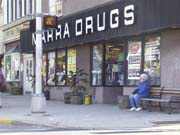Although the accessibility of Manhattan makes Hudson County an attractive residential destination for commuters, many are choosing to shop close to home, popping into the pharmacies, clothing stories and groceries on main streets. Smaller stores are doing well from the boom, and they’re also seeing shopping districts expand with new stores.
“This is just the beginning,” said Jerry Blankman, president of Jersey City’s Historic Downtown Special Improvement District, recently. The SID is an organization consisting of the area’s merchants who use the money from sales tax to promote the businesses in the area and make any improvements.
Getting recognized
One of the main shopping streets, Kennedy Blvd., snakes from Bayonne and Jersey City through West New York, Union City and North Bergen.
“I have a luxury here in this location,” said Peter DeGast, the owner of the IHOP on 32nd Street and Kennedy Blvd. in Union City, recently. “This is a main shopping center. We have Kids ‘R’ Us and Drug Emporium next door and a new shopping center across the street.”
DeGast was speaking of the Columbia Park Shopping Center in North Bergen, which includes an Old Navy, Macy Bed, and Staples.
“We are extremely stable,” said Oscar Miqueli, the coordinator of West New York’s Urban Enterprise Zone. “Not only on Bergenline Avenue, but throughout the town.”
With stores like Walgreen’s being constructed on 61st Street and Kennedy Blvd., and plans for a P.C. Richard and Son, West New York is looking forward to the growth.
“Businesses here have been getting stronger every year since the UEZ started in May 1996,” said Miqueli. The UEZ is a zone that allows selected stores to charge only 3 percent sales tax instead of the state’s 6 percent. Some of the tax that is collected goes back into improvements in the business district.
Small businesses on Bergenline Avenue and Weehawken’s Park Avenue have seen fewer turnovers and better business in recent years.
“There was a point maybe eight or seven years back when maybe 12 to 16 stores were vacant [in West New York],” said Miqueli. “Now I have seen that stop. Businesses are coming in and staying.”
Weehawken Mayor and West New York Business Administrator Richard Turner said, “There are more than 300 stores on Bergenline Avenue, and only two are vacant.”
Weehawken no longer has any vacant storefronts, Turner said. “There used to be a half a dozen vacant stores, and now they are all rented,” said Turner, who pointed to national statistics that say that a significant amount of new businesses fail every year. “In good times, obviously there [are] less.”
Shopping where you live
The main shopping districts in Hudson County are greatly affected by the flow of people coming into the towns to work every day, store owners said.
“The daytime population in Secaucus is very large,” said Darrin Marra, owner of Marra Drugs, a family business in Secaucus that has been open for the past 76 years.
According to statistics from Secaucus City Hall, that town’s nighttime population of 14,000 increases to anywhere between 50,000 and 70,000 during the day with shoppers and workers.
Jersey City’s Blankman said that in his town, the workers who don’t live in Jersey City probably shop closer to where they live. But not always. “There are more restaurants and pizzerias popping up,” said Blankman. “Restaurants that will deliver to new businesses during lunchtime have definitely felt a spike.”
And more people are moving to the area to use these businesses.
“Eventually, as the huge apartment towers become filled, then I imagine we will see an increase in business,” said Blankman, who owns Palace Drugs on Newark Avenue in Jersey City.
More than a dozen residential complexes are being built along the waterfronts of Jersey City, Hoboken, Weehawken and West New York.
“These people need services,” said Diane Stiglich, the owner of Galatea Lingerie on Washington and 12th streets in Hoboken, who recently opened Galatea Linens one block away. “I wouldn’t have opened the other store if I didn’t have this sense of growth developing in Hoboken.”
Stiglich added, “I once had what was considered the worst location in Hoboken. It was the last shop all the way on the end. Now, there are a lot of rental units there and I am very close to all of them.”
However, towns like Union City that do not have a waterfront are looking to develop as well. The two-block lot on Bergenline Avenue and 27th Street is being zoned for both residential and commercial space.
“That is where our biggest development is,” said DeGast. “There will be more spendable income if we get the right mix in there.”
Adapting to the changes
The new hotels in the area are also making a difference. People who do business in New York or visit the city and find it cheaper to stay in Hudson’s hotels are making use of local businesses.
“We do a lot of deliveries to hotels, we’ve never really done that before,” said Marra. “Businesses will send people to Manhattan, but then put them up in Secaucus hotels. This helps all of the businesses in town.”
All of the growth means that the county’s consumers are changing, and so are their needs. But stores are learning to adapt to the changes.
“I know I carry very different things in my store than I did six years ago,” said Stiglich. “If five people come in and ask for something that I don’t have, I go out and buy it.”
Stiglich added, “Any good business owner will have to adapt to the growing population.”
